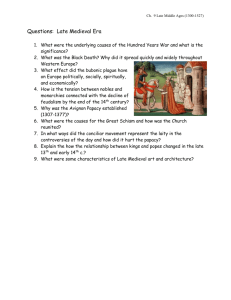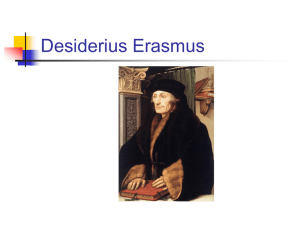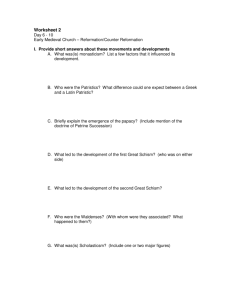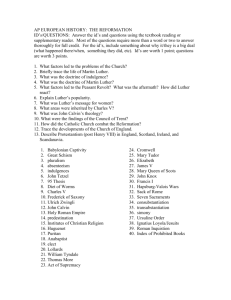PPP - Bama.ua.edu
advertisement
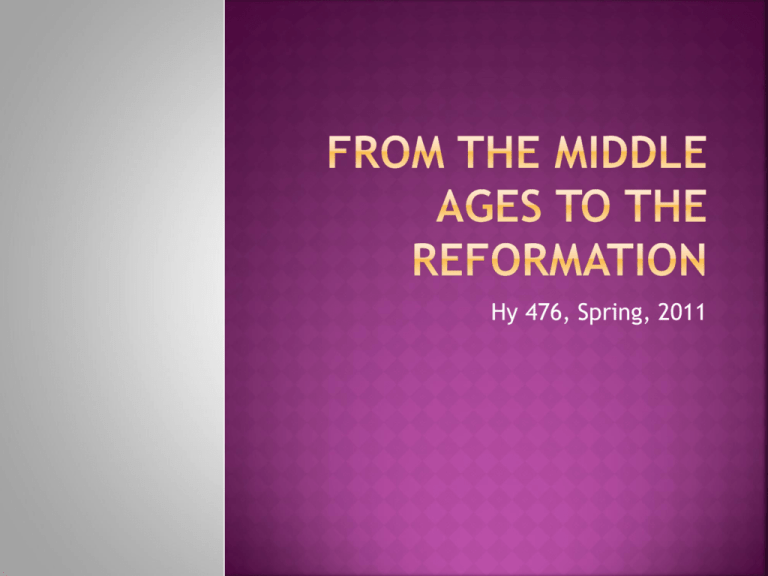
Hy 476, Spring, 2011 Reformist movement within monastic tradition, Cluny founded 909. Goal: rid the Church of abuses (,for instance, simony, the buying and selling of clerical offices, etc.) insistence on clerical celibacy, poverty and obedience. Rising conflict between Papacy and Emperor of Holy Roman Empire. Pope Urban II, 1095 Recapture the Holy Land Open it to pilgrims Stop Islam’s advance Promises of forgiveness of sins, straight ticket to heaven, bypassing Purgatory, etc. Good place for warring knights and feudal nobility. Jerusalem captured 1099, and held until 1187. Seven different crusades, included such romantic and chivalrous figures like King Richard the Lionhearted, etc. Even a Children’s Crusade Reconquista of Spain. Caused commerce to flourish, cities grew, and a renewed commitment to reform within the Church. St. Francis of Assisi St. Dominic of Guzmán Rise of universities and “scholasticism” St. Thomas Aquinas Ancient knowledge (Aristotle, etc.) reentered Western society through Moorish scholars of Spain. The Papacy in Decline Avignon, 1309-1377 Then, Great Schism (two Popes! 1378-1423) Conciliar movement given impetus by Papacy weakened by the schism. Popes became imbued with materialism of the Renaissance. Wanted to embellish and build splendid palaces and churches. Greater and greater resources needed to enjoy life and turn Rome into the artistic and intellectual capital of the world. Early reformers, such as John Wycliff of England and Jon Huss of Bohemia, challenged the secularization of the Church, the corruption of the clergy, the distance from Scripture. Began to call on the authority of the Bible to Reform the life and teachings of the Church. Both Huss and Wycliffe executed for heresy. Humanists devoted themselves to study of ancient texts and wanted to bring about reformation by returning to original texts of Christianity. Erasmus of Rotterdam the greatest of the humanists. Others embraced mysticism Church weakened by the residency in Avignon, the Great Schism, while the Popes became “more moved by the glories of the Renaissance than by the message of the cross.” Popes and their lives became involved in wars, intrigue, bribery and licentiousness. Corruption, concubinage, simony (buying and selling offices), all set the stage for reform. Teachings of Church also had gone astray. New translations (Greek, ancients through Arabic and Moorish Spain, etc.), new knowledge of original sources contrasted with traditions, canon law. Expressions of modern nationalism (writing in the vernacular, centralizing monarchies, search for national unity) contributed to breaks With the old hegemony and unity of the Church, especially now so much perceived as being corrupt. Book Cover, 1343 Italian; Siena Tempera on wood; H. 16 1/8 in. (41 cm), W. 9 3/4 in. (24.8 cm) Rogers Fund, 1910 (10.203.3) This painted wood panel once covered an account book compiled by the biccherna of Siena, a committee who served as administrators and treasurers of the commune. The scene at the top shows three of the five committee members, all of whose names are listed in the inscription below. The carmarlingo, or secretary, wearing the white robes of a Cistercian monk, counts a bag of money before two officers with record books. Rise of the humanists. Return to the original sources of Christianity, a love for classical letters of antiquity, promoting the reformation of the Church. Erasmus of Rotterdam the principal humanist. Of a modest home. Studied scholastic theology, turning instead to classical literature, and then to study of Scripture. Erasmus of Rotterdam Then mastered Greek, wrote Enchiridion Militis Christiani, or Handbook of the Christian Soldier, expounded on the Christian life for “soldiers of Christ.” Combined in his teachings the commandments of Jesus with the best precepts of Stocism and Platonism. Subject passion to reason. He rejected the pomp and vices and search for earthly glories of the popes of the Renaissance. Also was critical of monks and monasteries which had become havens of idleness and ignorance. His goal was inward change and purification. “Erasmus convinced that the Christian warfare was an inner one.” He sought “the reformation of customs, the practice of decency and moderation, an inner devotion shaped by learning and meditation, and a church than encouraged these things” (p. 11) Generally agreed, Luther, along with John Calvin, the two leaders of the Reformation. Huldrych Swingli, a Swiss, generally regarded as the “third man” of the Reformation. Luther born in Eisleben, Germany. Father a miner and small manufacturer, wanted Luther to become a lawyer. Luther started at university in Erfurt in 1501. Father very strict. The source of much personal anguish.
